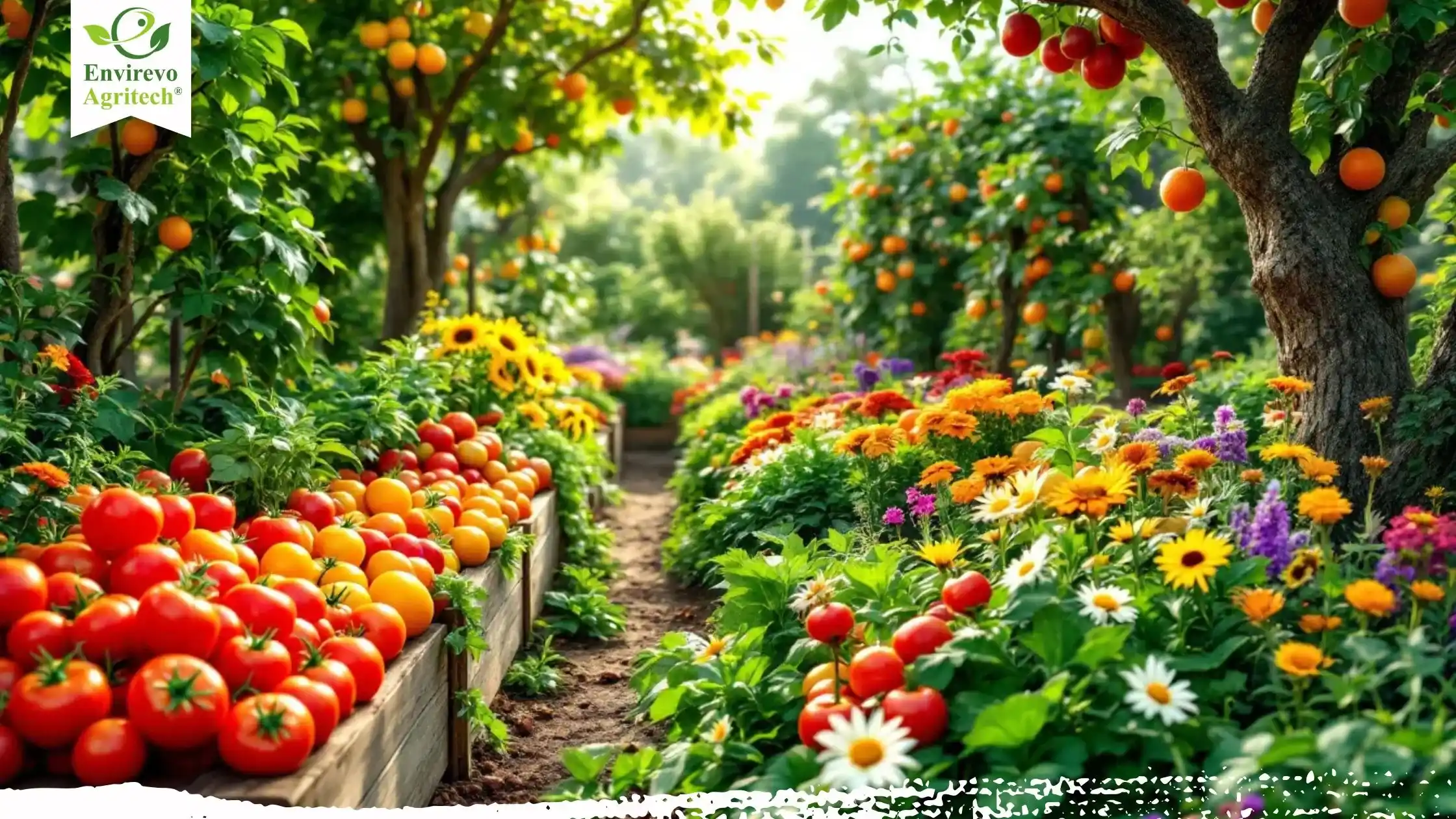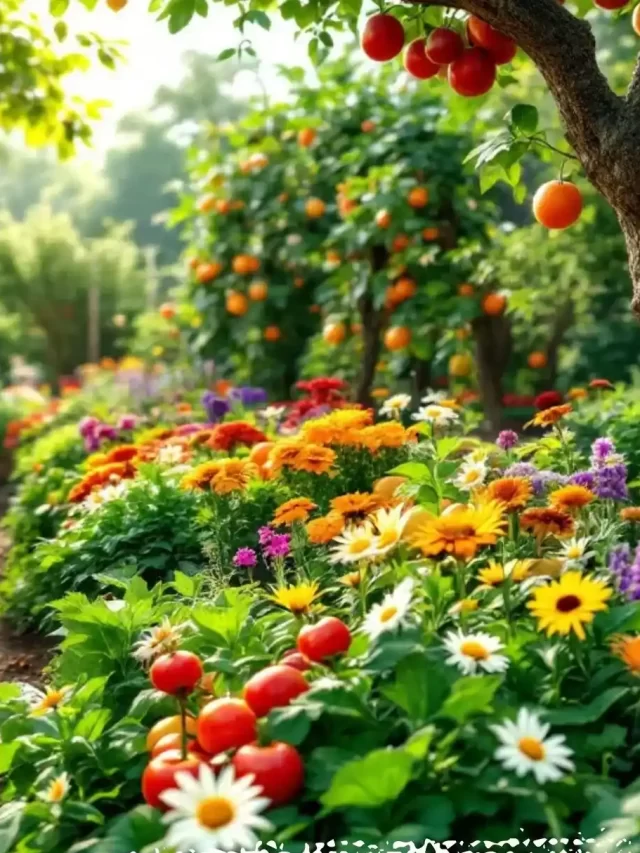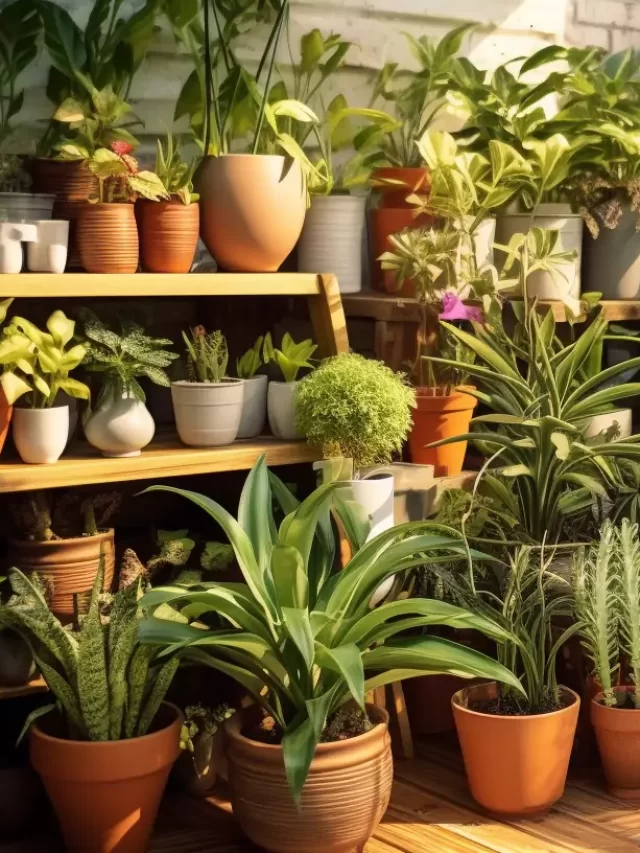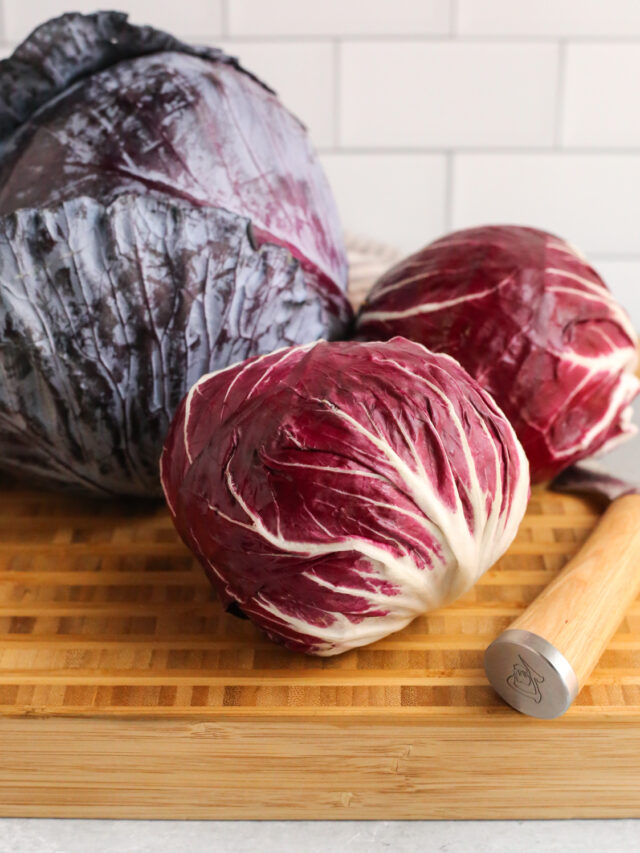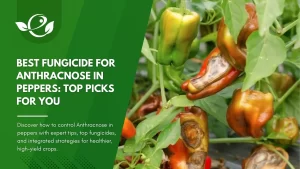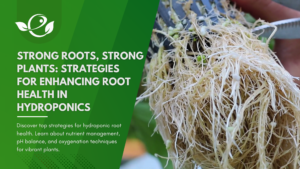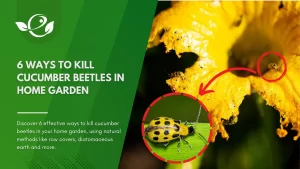Table of Contents
Edible perennials are the ultimate “plant once, harvest forever” solution for home gardeners seeking both abundance and ease in their kitchen plots. Edible perennials are long-lived plants that return harvests year after year with minimal replanting, offering gardeners sustainable, cost-effective, and ecologically beneficial crops for kitchen gardens. Below is an in-depth guide to growing 16 Edible Perennials in your kitchen garden—each planted once, harvested year after year. We’ll cover benefits, planning, detailed plant profiles with growing tips, and troubleshooting.
What Are Edible Perennials?
Edible perennials are plants that live for more than two years and produce harvestable food without needing annual replanting. Unlike annuals, which complete their life cycle in one season, perennials establish a lasting root system that regenerates new shoots each year.
Once established, edible perennials reduce labor, seed costs, and soil disturbance, making them eco-friendly and budget-wise. They enhance soil structure, support beneficial insects, and provide year-round harvests, boosting both biodiversity and food security.
16 Must-Grow Edible Perennials
1. Asparagus
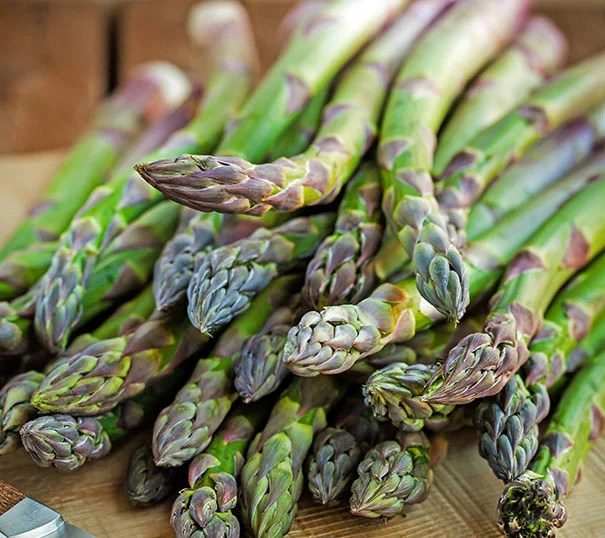
Asparagus is the quintessential spring harbinger, shooting elegant green spears that taste like the very essence of the season. Though patience is required—no harvest until year three—once established, a well-tended bed will reward you for 15–20 years with tender, succulent stalks. Its upright ferny foliage not only enriches garden structure but feeds soil health as it dies back in autumn. Chefs prize the vegetal sweetness of young spears, which roast, steam, or grill superbly; pick when 15–20 cm tall, before tips unfurl. With deep roots that suppress weeds and improve aeration, asparagus makes a cornerstone of any perennial plot.
- Scientific name: Asparagus officinalis
- Ideal conditions: Full sun; deep, fertile, well-drained soil
- Planting tips: Plant 1-year-old crowns 10–15 cm deep, 30 cm apart, in spring.
- Harvest timing: From 3rd year onward; harvest spears when 15–20 cm tall in spring
- Culinary uses: Steamed, roasted, stir-fried, soups, salads
- Maintenance notes: Mulch deeply, remove ferns in fall, rotate every 15 years
Fun fact: Ancient Romans prized asparagus enough to transport fresh shoots on ice to emperors.
2. Rhubarb
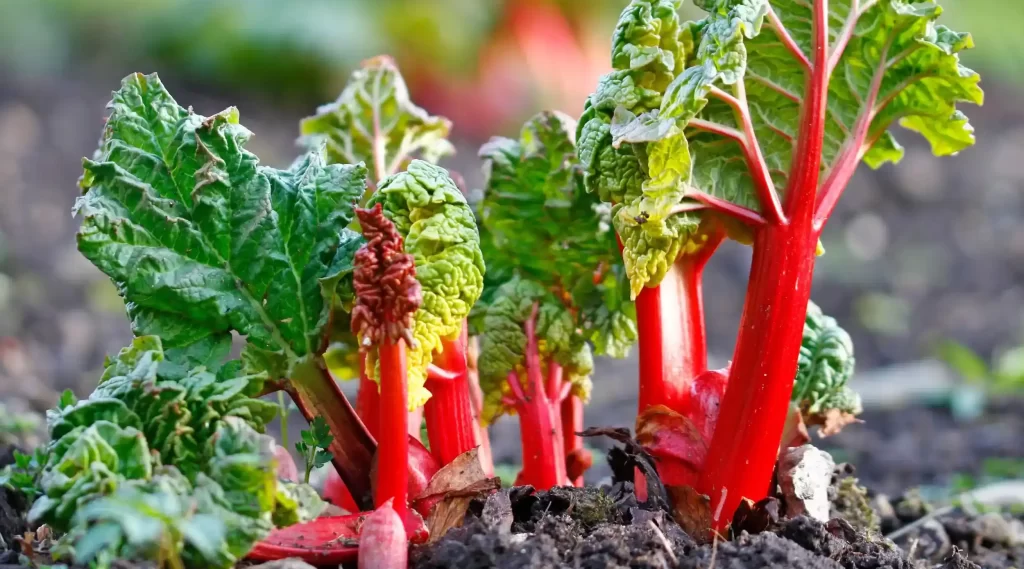
Rhubarb adds drama and tang to early-season desserts with its vivid red stalks, yet it’s a low-fuss perennial that can thrive for decades. Plant crowns in rich, slightly acidic soil, and resist harvesting in year one so the crown establishes. By year two, you’ll snip stalks 30–45 cm long through spring and early summer—then step back as giant palmate leaves cloister the bed for the rest of the warm months. Beyond pies and compotes, rhubarb brightens chutneys and cocktails. Although its leaves are toxic, the stalks store well when frozen or canned. Divide every 5–7 years to rejuvenate vigor and guard against crown rot with winter mulch.
- Scientific name: Rheum rhabarbarum
- Ideal conditions: Full sun; rich, slightly acidic to neutral soil; good drainage
- Planting tips: Plant crowns 5 cm below the soil surface, 90 cm apart, in early spring.
- Harvest timing: From the 2nd year; cut stalks when 30–45 cm long, in spring/early summer
- Culinary uses: Pies, compotes, jams, sauces, beverages
- Maintenance notes: Divide every 5–7 years; mulch in winter; avoid eating leaves (toxins)
Fun fact: Victorian kitchens forced rhubarb under covers to produce blanched “forcings” for January harvests.
3. Strawberries
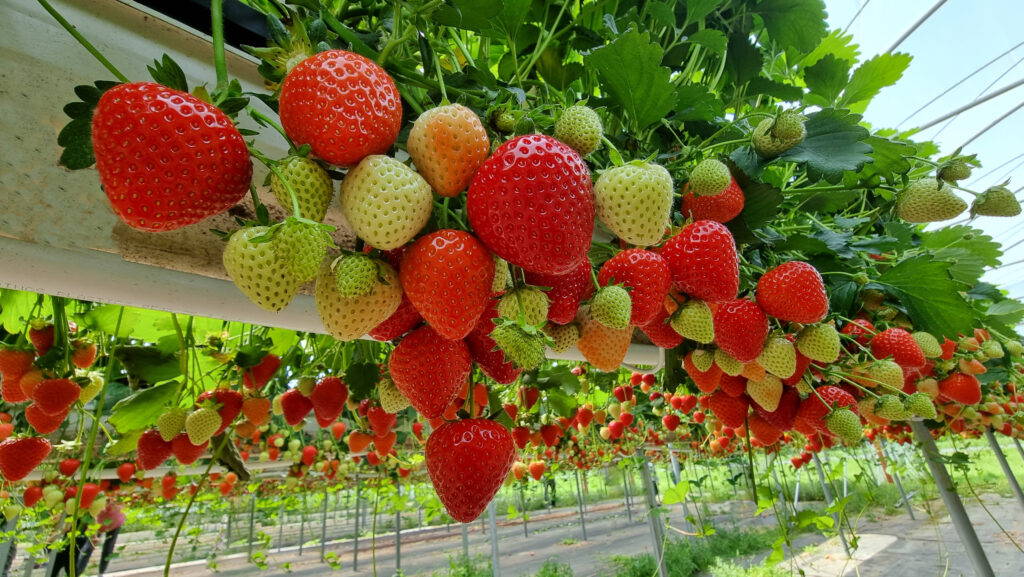
Strawberries deliver sweet rewards in compact mounds, perfect for containers, hanging baskets, or groundcover. Everbearing and day-neutral cultivars stretch harvests from late spring through frost, while June-bearers pack a single mid-season bounty. Remove early flowers in year one to build strong roots; thereafter, enjoy berries on fleshy trusses. Their glossy green leaves form a lush mat that deters weeds and conserves moisture when mulched. From morning yogurt parfaits to jam-streaked pastries, these little gems are culinary multitaskers. Renew beds every 3–4 years by renewing planting spots or rotating in fresh crowns for maximum productivity.
- Scientific name: Fragaria × ananassa
- Ideal conditions: Full sun; fertile, well-drained loam; pH 5.5–6.5
- Planting tips: Space 30 cm apart, crowns at soil level; remove flowers first year to establish roots.
- Harvest timing: Late spring to fall on everbearing types
- Culinary uses: Fresh eating, desserts, preserves, smoothies
- Maintenance notes: Cut back runners to channel energy; mulch for winter protection; renew beds every 3–4 years
Fun fact: Strawberries are 90% water and contain more vitamin C per serving than oranges.
4. Blueberries
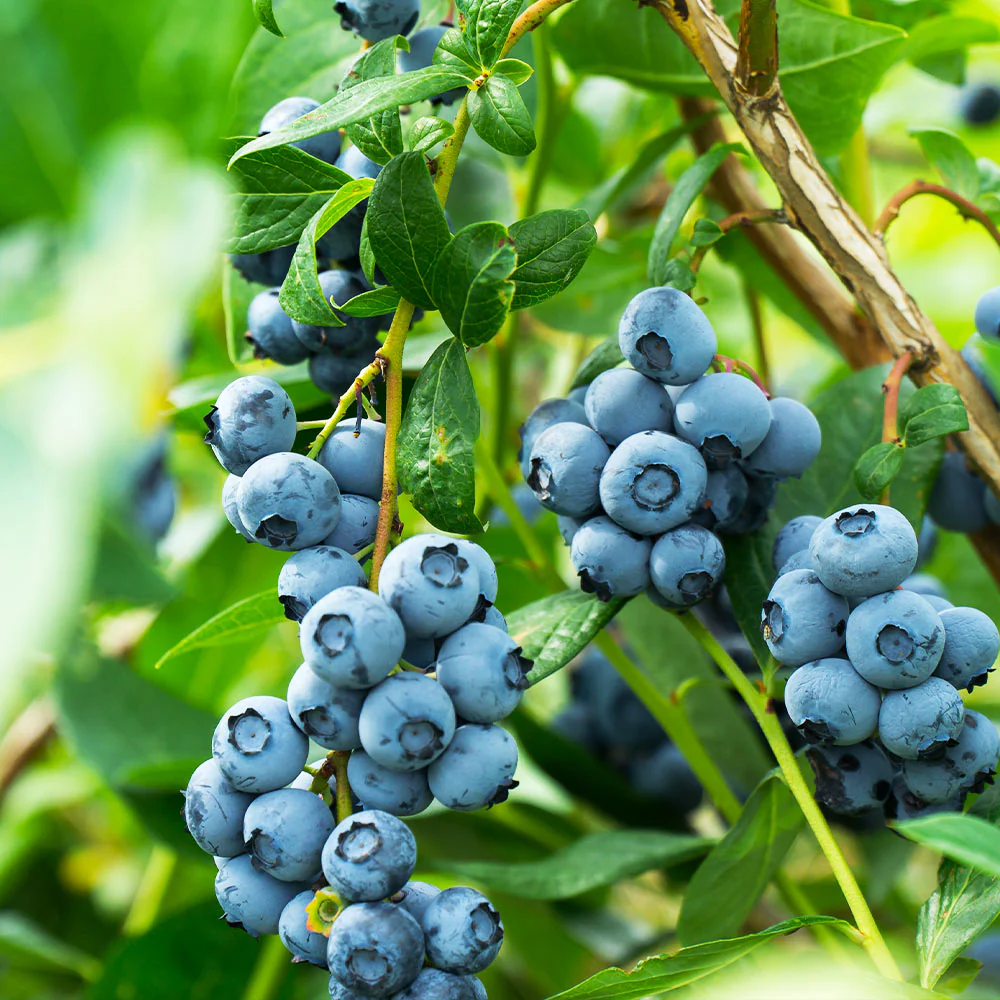
Blueberries enchant with clusters of indigo orbs bursting with antioxidants—and autumn’s fiery foliage adds ornamental value. Native to acidic soils, they thrive under a mulch of pine needles or sulfur-enriched amendments. Requiring full sun and even moisture, they reward dual planting (early and late ripening) for cross-pollination and extended picking. Clear ripe berries by mid-summer; at peak sweetness, they blend into jams, sauces, or nutritious snacking. Annual pruning opens the canopy, encourages new fruiting wood, and curbs alternate bearing. With proper care, your bushes can produce for decades, making blueberries a favorite edible perennial.
- Scientific name: Vaccinium corymbosum (Highbush) or V. angustifolium (Lowbush)
- Ideal conditions: Full sun; acidic (pH 4.5–5.5), moist, well-drained soil
- Planting tips: Plant dormant bare-root or container plants 45–60 cm apart, in autumn or spring.
- Harvest timing: Summer; berries ripen mid to late season depending on variety
- Culinary uses: Fresh, baking, jams, sauces, smoothies
- Maintenance notes: Prune annually to remove old wood; apply ericaceous fertilizer; mulch to retain moisture
Fun fact: Blueberries must be cross-pollinated by a different variety to set fruit effectively.
5. Blackberries
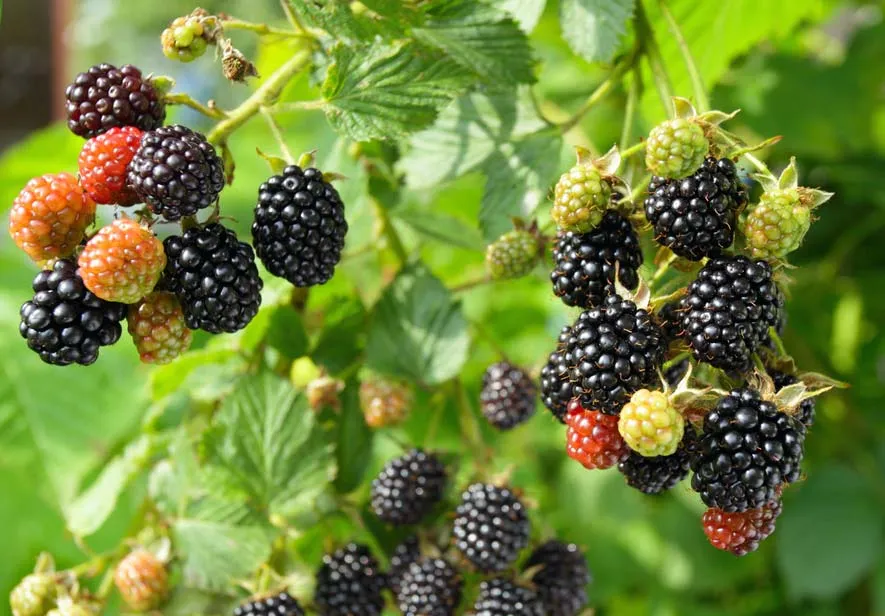
Blackberries yield bramble-sweet fruit on vigorously trailing or erect canes—thornless cultivars make for easier harvest. Plant at the hedge’s edge or train canes on a trellis for neat rows and good air circulation. Expect fruit in midsummer; thinning clusters ensures larger berries with richer flavor. The plant’s arching canes form a handsome summer silhouette, then dry into winter interest. Prune spent floricanes each year and clip primocanes to manage height. Harvest fresh or freeze for pies, jams, and liqueurs, and enjoy an abundant yield from minimal inputs.
- Scientific name: Rubus fruticosus aggregate
- Ideal conditions: Full sun; fertile, well-drained soil; shelter from strong winds
- Planting tips: Space 1.2–1.5 m apart; train canes on wires; prune primocanes after fruiting.
- Harvest timing: Mid to late summer, once berries turn glossy black
- Culinary uses: Pies, jams, syrups, fresh eating, wine
- Maintenance notes: Remove dead canes yearly; mulch to suppress weeds; control spread by digging out root suckers
Fun fact: Blackberry roots were used in traditional medicine to treat diarrhea and inflammation.
6. Grapes
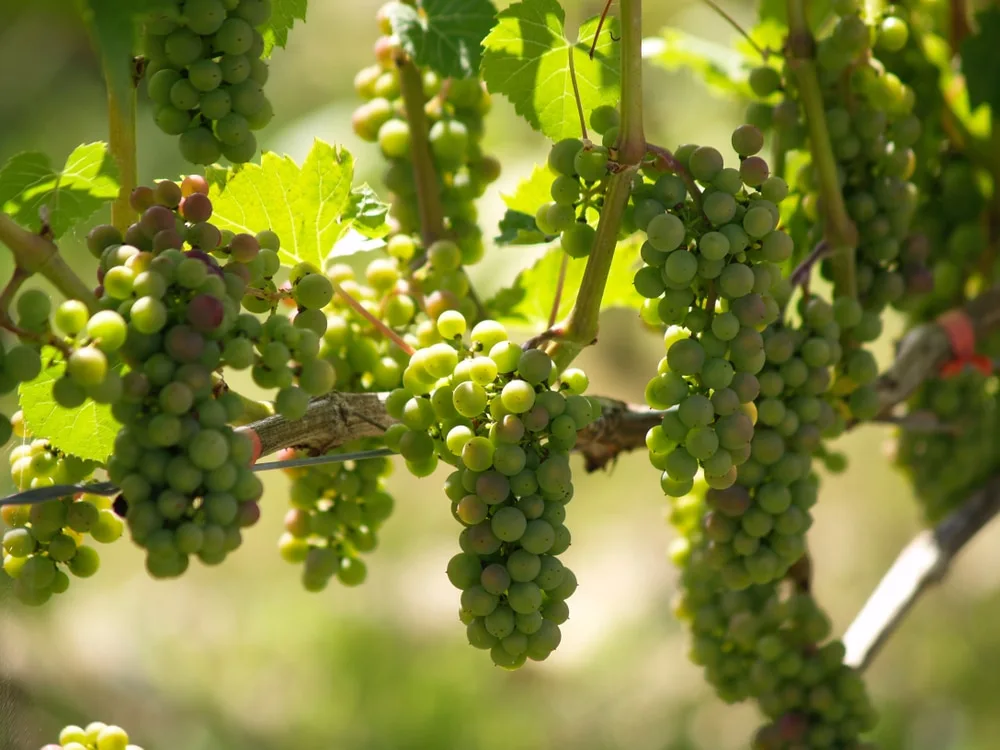
Grape vines drape pergolas and fences with verdant foliage and dangling clusters of table or wine grapes. Require a sturdy trellis, well-drained soil, and full sun for optimal sugar development. Once roots establish—after two summers—you’ll thin clusters and trim shoots to focus energy into fruit, harvesting late summer or early fall. Their tendrils and broad leaves provide shade and privacy, and the edible leaves can be blanched for dolmas. With annual pruning and bird netting, vines produce for half a century or more, delivering fresh fruit, jams, and homemade wine.
- Scientific name: Vitis vinifera
- Ideal conditions: Full sun; well-drained loam; pH 6.0–6.8
- Planting tips: Plant in spring; space vines 2–3 m apart; train on sturdy trellis or fence.
- Harvest timing: Late summer to autumn, when sugar content peaks
- Culinary uses: Table grapes, jams, jellies, wine, raisins
- Maintenance notes: Annual cane pruning; thin fruit clusters for quality; protect from birds/netting
Fun fact: Grapevines can live over 100 years; the world’s oldest productive vine is in Maribor, Slovenia (over 400 years old).
7. Mint
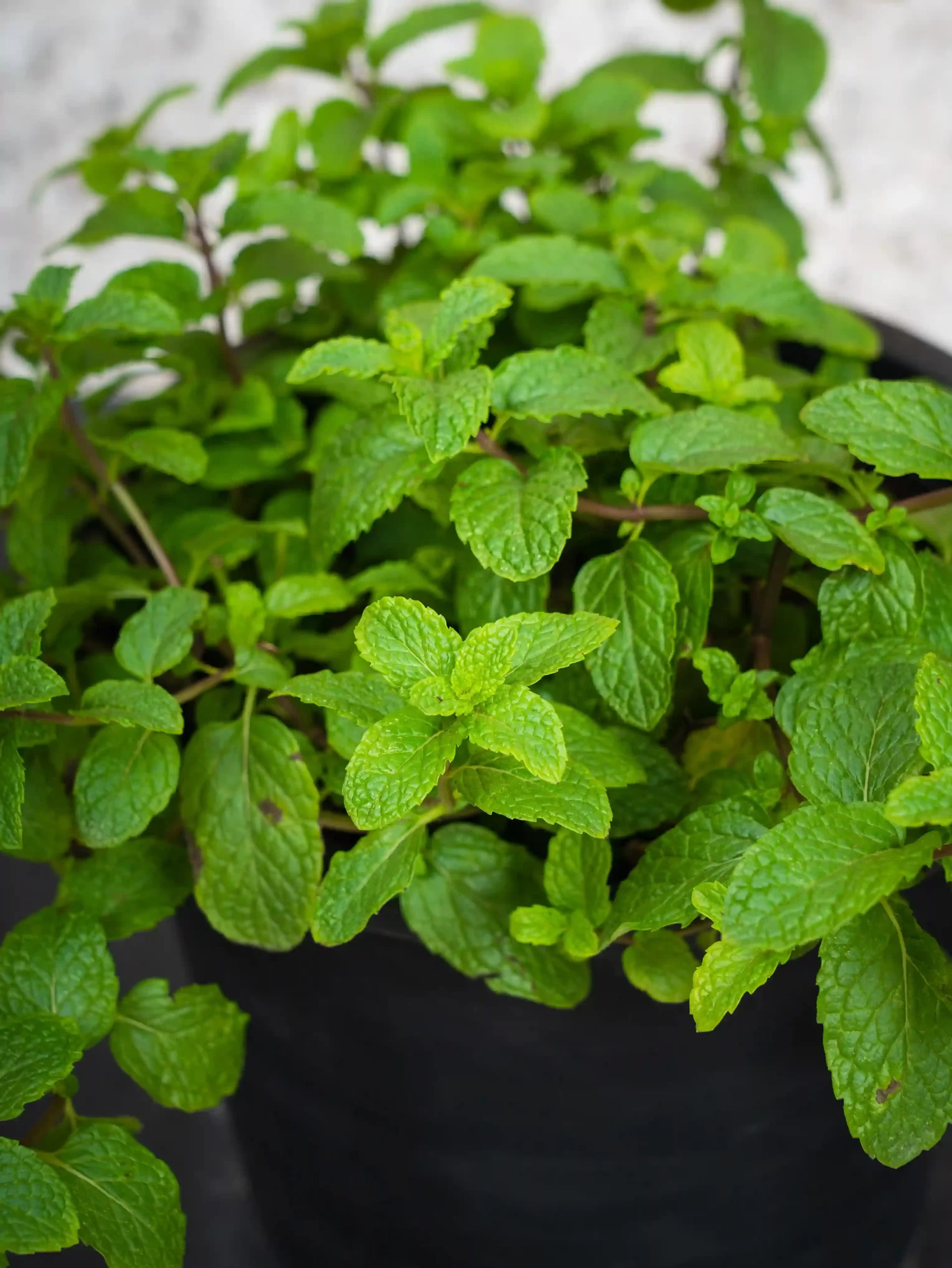
Mint explodes with fragrant foliage—ideal for teas, salads, and cocktails. Because it spreads via runners, containment (pots or buried barriers) is key. Harvest leaves just before flowering for peak aroma; frequent cutting encourages bushy growth. Part shade toleration makes it versatile in herb gardens or shady beds. Its vigorous root network suppresses weeds but demands vigilance to prevent overtaking. Use fresh or dried in recipes, and enjoy mint’s reputation as a natural digestive aid. Restore vigor by dividing every few years.
- Scientific name: Mentha × piperita (peppermint) or M. spicata (spearmint)
- Ideal conditions: Full sun to part shade; fertile, moist, well-drained soil
- Planting tips: Start from root cuttings, in pots or a contained bed; divide every 2–3 years.
- Harvest timing: Trim leaves continuously; best before flowering
- Culinary uses: Teas, cocktails, salads, sauces, desserts
- Maintenance notes: Deadhead flowers to prolong foliage; overwinter mulch in cold climates
Fun fact: Ancient Egyptians used mint in funerary rites; Greeks drank mint wines for digestion.
8. Thyme
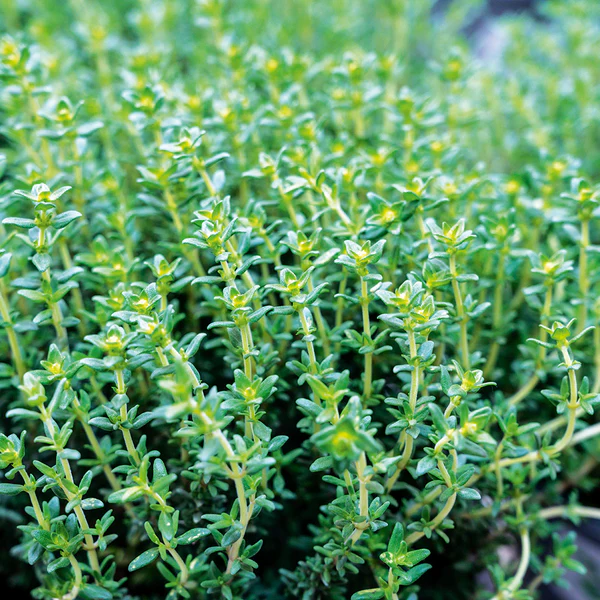
Thyme’s woody stems and tiny, intensely aromatic leaves lend themselves to Mediterranean dishes and garden accents alike. Drought-tolerant once established, it thrives in poor, well-drained soil under full sun. Snip sprigs before flowering and use fresh or dried in roasts, soups, and herb blends. Its mat-forming habit suppresses weeds and attracts pollinators when in bloom. Refresh thyme every 3–4 years by dividing or replacing to prevent woody decline.
- Scientific name: Thymus vulgaris
- Ideal conditions: Full sun; light, well-drained soil; drought tolerant
- Planting tips: Space 20–30 cm apart; plant in spring; avoid overwatering.
- Harvest timing: Snip sprigs before flowering; year-round in mild climates
- Culinary uses: Roasts, soups, stews, herb blends (bouquet garni)
- Maintenance notes: Trim after flowering; replace every 3–4 years to prevent woodiness
Fun fact: Thyme oil contains thymol, a compound used in mouthwashes and antiseptics.
9. Oregano
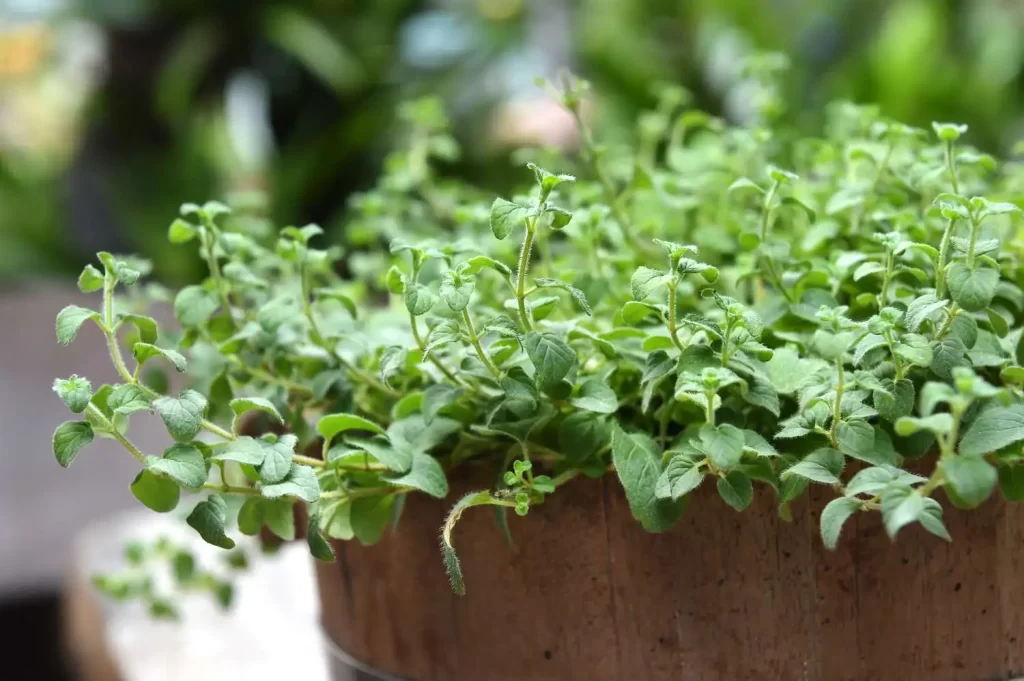
Oregano brings peppery depth to tomato sauces and grilled dishes—its flavor intensifies when dried. Plant in sunny, well-drained spots and pinch young shoots to encourage branching. Harvest leaves at peak, just before bloom, and dry stems for winter use. Its compact, mounding form fills gaps and deters weeds. Divide every 3–4 years to rejuvenate flavor and prevent the center from hollowing out.
- Scientific name: Origanum vulgare
- Ideal conditions: Full sun; well-drained, moderately fertile soil
- Planting tips: Space 25–30 cm apart; plant in spring; pinch new growth to bush out.
- Harvest timing: Harvest leaves just before flowering for peak flavor
- Culinary uses: Pizza, pasta sauces, meat rubs, marinades
- Maintenance notes: Divide clumps every 3–4 years; protect in winter with light mulch
Fun fact: Oregano’s aroma intensifies when dried—fresh leaves are milder than dried.
10. Rosemary
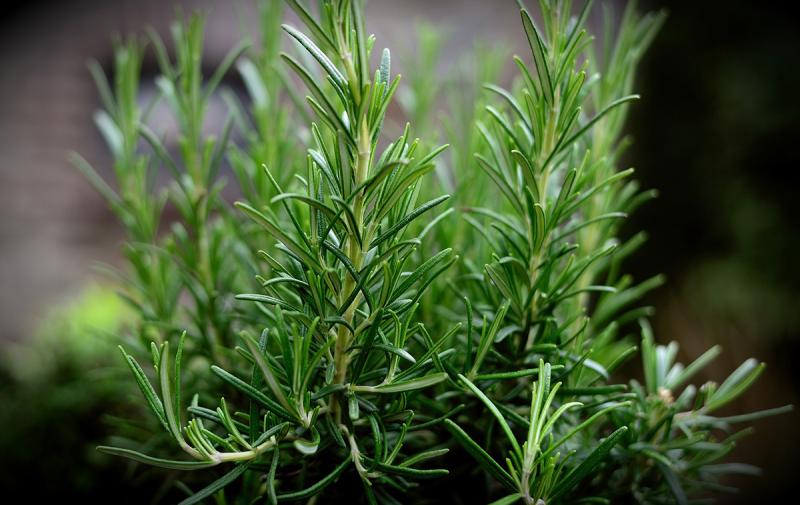
Rosemary offers evergreen, needle-like leaves that perfume roasts and breads. Thriving in sandy, alkaline soils under full sun, it makes a drought-tolerant border or container specimen. Clip fresh sprigs year-round for cooking; prune after flowering to maintain shape. Its aromatic oils serve as natural pest deterrents. Protect roots with light mulch in harsh winters and propagate easily by stem cuttings to expand your herb collection.
- Scientific name: Salvia rosmarinus
- Ideal conditions: Full sun; sandy, well-drained soil; drought tolerant
- Planting tips: Space 60–90 cm apart; plant in spring; avoid waterlogged sites.
- Harvest timing: Cut sprigs as needed; best before flowering
- Culinary uses: Roasts, breads, oils, liqueurs
- Maintenance notes: Prune after flowering; mulch lightly for winter; propagate by cuttings
Fun fact: Rosemary is associated with memory enhancement in folklore and literature.
11. Chives
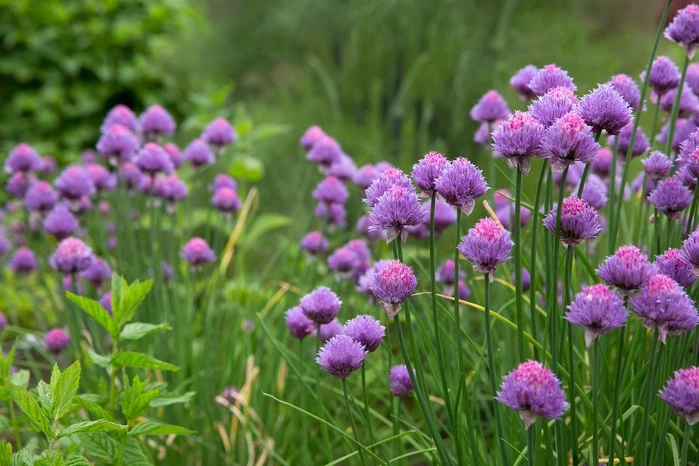
Chives form tidy clumps of grass-like leaves and purple allium blooms that delight pollinators. Snip foliage continuously for garnishes—flowers and leaves alike are edible. They naturalize well in beds and containers, reducing soil erosion and weeds. Best grown in full sun to part shade, chives are hardy and trouble-free. Divide clumps every 3 years to maintain vigor and prevent overcrowding.
- Scientific name: Allium schoenoprasum
- Ideal conditions: Full sun to part shade; moist, fertile, well-drained soil
- Planting tips: Divide clumps every 3 years; plant crowns just below soil surface.
- Harvest timing: Snip leaves regularly; flower stalks edible or cut back for foliage
- Culinary uses: Garnish, omelettes, dips, salads, herb butters
- Maintenance notes: Allow some blooms for pollinators; tidy seed heads to redirect energy to foliage
Fun fact: All parts of chives, including flowers, are edible and rich in vitamin C.
12. Horseradish
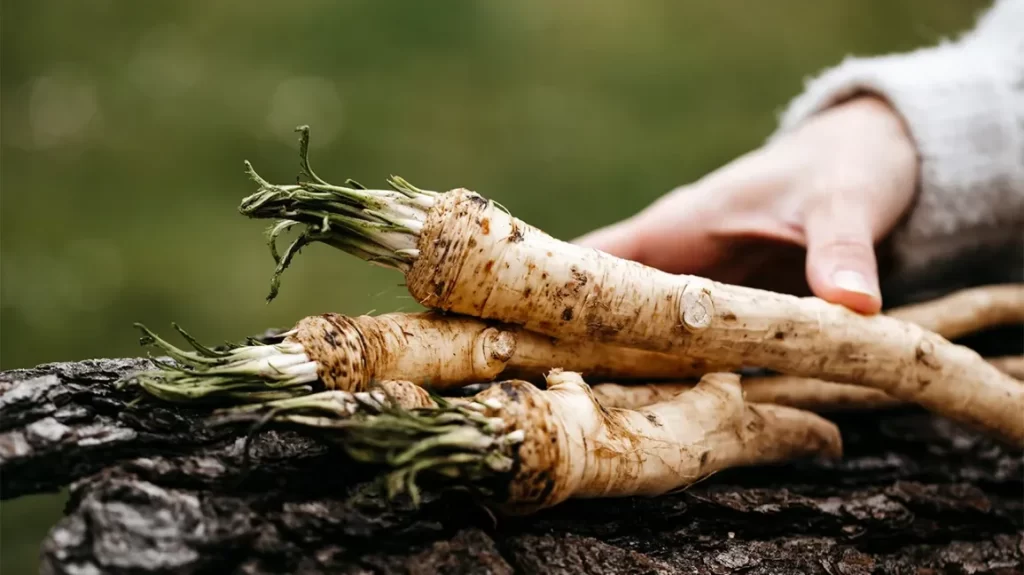
Horseradish delivers a fiery punch to condiments and sauces, with its pungent root grated fresh to release allyl isothiocyanate. Plant root cuttings in deep, fertile soil and let foliage grow for one season before harvesting. Dig roots in late autumn or early spring and replant a portion to perpetuate the patch. Its coarse leaves also make an appealing border, but contain spread by removing stray roots. Divide every 3–4 years to maintain potency and manage vigor.
- Scientific name: Armoracia rusticana
- Ideal conditions: Full sun to partial shade; deep, fertile, well-drained soil
- Planting tips: Plant root ‘thongs’ 10–15 cm deep, 30 cm apart, in spring.
- Harvest timing: Dig roots in late fall or early spring before new growth
- Culinary uses: Condiments, sauces, vinaigrettes, cocktails
- Maintenance notes: Contain spread via roots; divide clumps every 3–4 years
Fun fact: Horseradish’s heat comes from allyl isothiocyanate, a volatile compound released when the root is crushed.
13. Sorrel
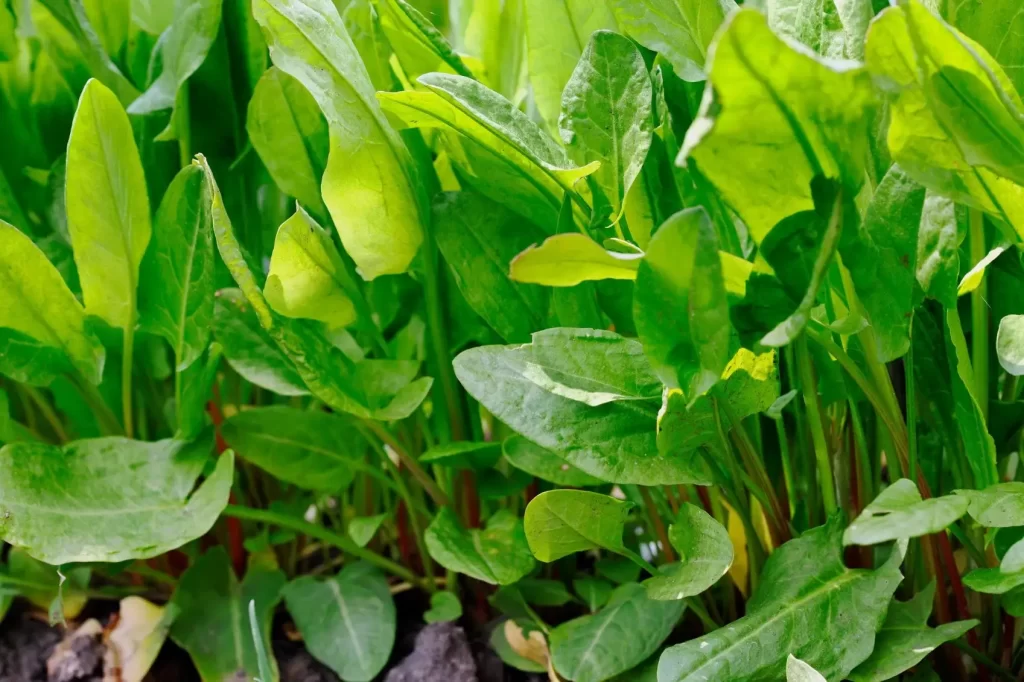
Sorrel bursts onto the scene in early spring with tangy, arrow-shaped leaves that taste of lemon—perfect for soups, salads, and sauces. Its basal rosette persists through mild winters, offering a first taste of green before most perennials stir. Sow seeds thinly or divide crowns, then cut leaves regularly to encourage fresh growth. Heat triggers flowering; pinch buds to prolong leaf season. With low maintenance and quick regrowth, sorrel is a zesty asset to any edible border.
- Scientific name: Rumex acetosa
- Ideal conditions: Full sun to part shade; cool, moist, well-drained soil
- Planting tips: Sow seeds or divide crowns 30 cm apart, in spring or autumn.
- Harvest timing: Cut leaves 10–15 cm long, before flowering; remove some flowering stalks to prolong leaf quality
- Culinary uses: Salads, soups (e.g., sorrel soup), sauces, smoothies
- Maintenance notes: Divide every 3–4 years; pinch flower buds to extend leaf harvest
Fun fact: Sorrel contains oxalic acid, which imparts its signature sour taste.
14. Lovage
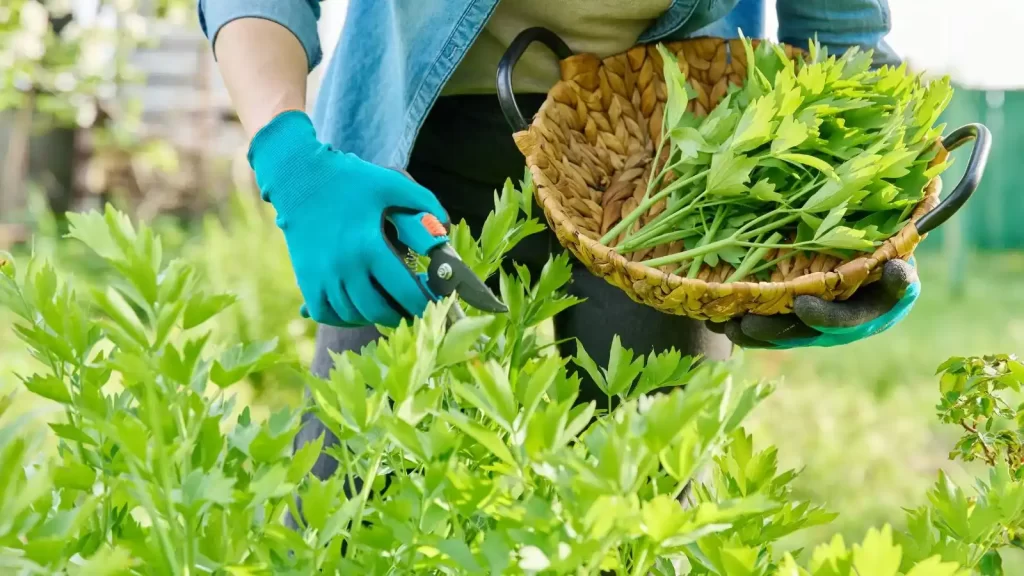
Lovage shoots skyward with celery-like stalks and parsley-flavored leaves, lending height and flavor to soups and stocks. A single planting yields for years—cut leaf stems near the base all season, and harvest umbels for seeds in autumn. It prefers rich, moist soil in sun or part shade and fills the herb border’s back with architectural presence. Divide every 4–5 years to invigorate clumps. Legend says medieval cooks used lovage seeds as pepper substitutes when true pepper was scarce.
- Scientific name: Levisticum officinale
- Ideal conditions: Full sun to part shade; rich, moist, well-drained soil
- Planting tips: Space 60 cm apart; sow seeds indoors 6–8 weeks before last frost; transplant after danger of frost.
- Harvest timing: Cut leaf stalks as needed; harvest seeds in autumn
- Culinary uses: Soups, stocks, stews, salads, pickles
- Maintenance notes: Divide every 4–5 years; protect young crowns with mulch
Fun fact: In medieval times, lovage was used to repel insects and treat digestive ailments.
15. Jerusalem Artichoke
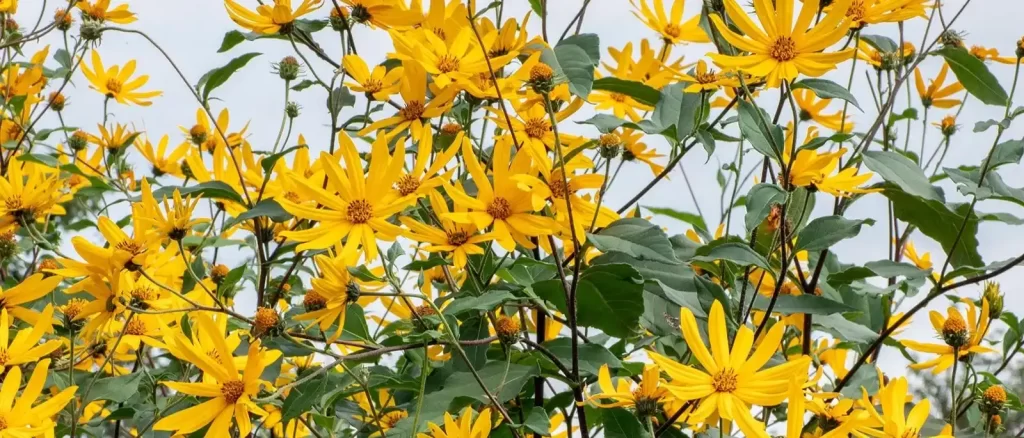
Jerusalem artichokes surprise with towering sunflower-like blooms and crunchy, nutty-flavored tubers often called sunchokes. Plant tubers 10 cm deep in spring; they’ll multiply vigorously—dig only what you need to curb spread. Harvest after first frost when tubers taste sweetest, then store unwashed in sand or clip back stalks. Their resilient nature tolerates poor soils and drought, making them ideal for novice growers seeking ground-cover and edible yield in one.
- Scientific name: Helianthus tuberosus
- Ideal conditions: Full sun; any well-drained soil; tolerates poor fertility
- Planting tips: Plant tubers 10 cm deep, 30 cm apart, in early spring.
- Harvest timing: Late autumn through winter after frost; dig as needed
- Culinary uses: Roasted, mashed, soups, salads (thinly sliced)
- Maintenance notes: Contain spread by harvesting all tubers; divide clumps every 3 years
Fun fact: Despite its name, Jerusalem artichoke isn’t related to artichokes and likely derives its name from the Italian “girasole” (sunflower).
16. Fennel
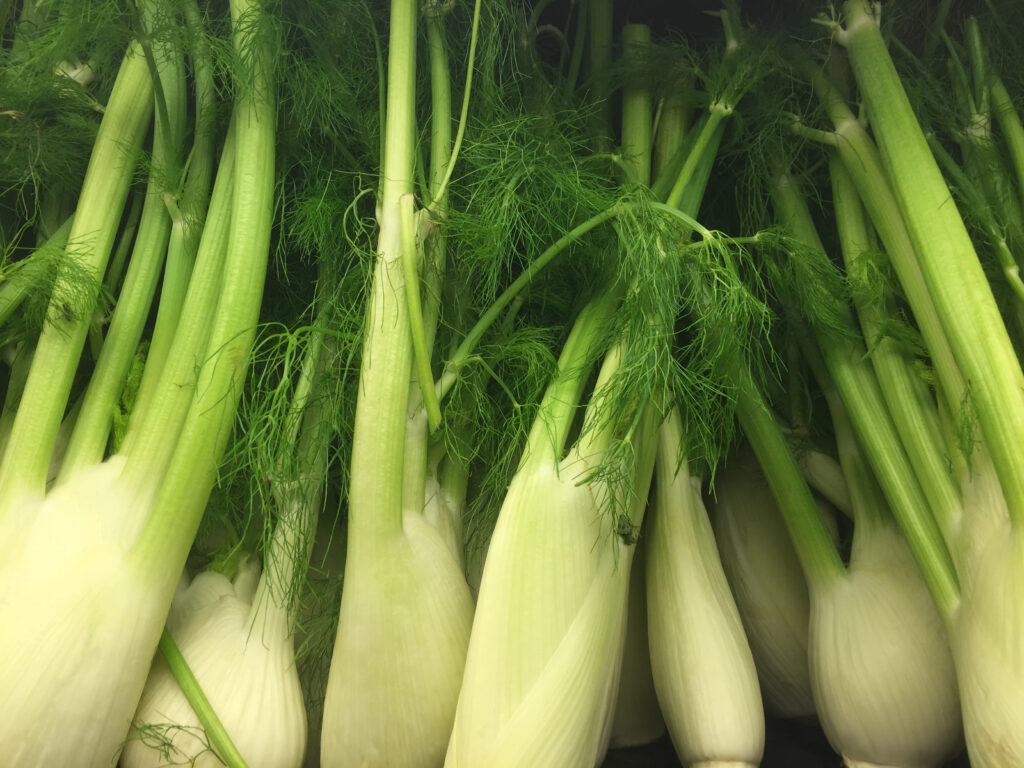
Fennel’s feathery fronds and yellow umbels add lacy beauty and anise-sweet flavor to gardens and plates alike. In spring, sow seeds or transplant seedlings in rich, well-drained soil; subsequent bulbs swell to 5–8 cm in late summer. Fronds and pollen enhance fish dishes and salads, while seeds dry for spice blends. Cut flower stalks to focus energy on bulbs. With proper division every 3–4 years, fennel remains a striking, aromatic perennial for years.
- Scientific name: Foeniculum vulgare var. dulce
- Ideal conditions: Full sun; rich, well-drained soil; shelter from strong winds
- Planting tips: Sow seeds directly or transplant seedlings 30 cm apart in spring after frost risk.
- Harvest timing: Harvest fronds continuously; dig bulbs late summer when 5–8 cm thick
- Culinary uses: Salads, braises, soups, fish dishes, herb infusions
- Maintenance notes: Cut back flower stalks to focus energy on bulbs; divide every 3–4 years
Fun fact: Fennel seeds were carried by Greek soldiers for endurance and by ancient Romans as breath fresheners.
Year-Round Harvest Planning
Create a seasonal calendar to visualize staggered yields:
- Spring: Asparagus, rhubarb, sorrel
- Summer: Strawberries, blueberries, blackberries, herbs
- Fall: Grapes, horseradish, lovage seeds
- Winter: Rosemary, thyme leaves
Rotate and succession-plant annuals between perennial rows to bridge harvest gaps
Benefits of Edible Perennials in Your Kitchen Garden
- Time and Cost Savings: Plant once and enjoy multiple seasons’ yields—no reseeding each spring cuts time and nursery expenses.
- Environmental and Ecological Advantages: Deep perennial roots improve soil aeration, water infiltration, and carbon sequestration, while perennial foliage offers habitat for pollinators and predatory insects.
- Culinary Diversity Year-Round: From tender spring asparagus to evergreen rosemary in winter, edible perennials diversify meals across seasons without relying solely on annual rotations
Conclusion
Embracing edible perennials in your kitchen garden means investing in a living harvest that returns value year after year, saving you time, money, and labor while enhancing ecological resilience. From the first tender shoots of asparagus in spring to the aromatic sprigs of rosemary through winter, these plants ensure a steady pipeline of fresh, home-grown flavors without the annual scramble to sow and replant.
By selecting a diverse palette of 16 proven perennials, you’ll enjoy continuous seasonal yields, enrich your soil, and support beneficial wildlife, all with a fraction of the upkeep required by traditional vegetable beds. Now is the perfect time to choose your starter perennials, prepare your site, and embark on a “grow once, harvest forever” journey that will reward you for many seasons to come.
